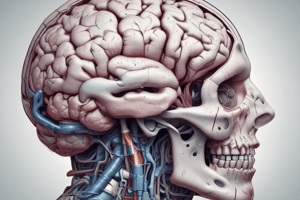Podcast
Questions and Answers
What does the term Hypothermia mean?
What does the term Hypothermia mean?
Hypothermia is when the body has a low body temperature
In the event of hypothermia, enzymes don't work in cold body temperature
In the event of hypothermia, enzymes don't work in cold body temperature
True (A)
What effect does hypothermia have on the body?
What effect does hypothermia have on the body?
Hypothermia can affect several functions of the body, specifically the heart, brain, and lungs. It can lead to difficulty breathing and slow the heart rate.
What are the reasons why the body loses heat in hypothermia?
What are the reasons why the body loses heat in hypothermia?
What is the meaning of the term 'Metabolic acidosis'?
What is the meaning of the term 'Metabolic acidosis'?
What effect does Metabolic acidosis have on the body?
What effect does Metabolic acidosis have on the body?
When there is a deficiency of Oxygen in the body, it starts producing lactate
When there is a deficiency of Oxygen in the body, it starts producing lactate
Metabolic acidosis affects electrolytes like Calcium
Metabolic acidosis affects electrolytes like Calcium
Drugs work properly in an imbalanced conditions
Drugs work properly in an imbalanced conditions
An imbalanced PH can lead to ineffective treatment
An imbalanced PH can lead to ineffective treatment
It's ideal to maintain a balanced PH for a proper and effective treatment
It's ideal to maintain a balanced PH for a proper and effective treatment
What is 'The Lethal Triad'?
What is 'The Lethal Triad'?
What is the meaning of coagulopathy?
What is the meaning of coagulopathy?
What is the impact of coagulopathy on the body?
What is the impact of coagulopathy on the body?
What are the symptoms of coagulopathy?
What are the symptoms of coagulopathy?
What is the process of clotting in the body?
What is the process of clotting in the body?
What is DIC?
What is DIC?
What happens in the body when the clotting factors run out?
What happens in the body when the clotting factors run out?
What happens to the body when it forms too many micro clots?
What happens to the body when it forms too many micro clots?
Tranexamic acid can be given to a patient to control excessive clotting.
Tranexamic acid can be given to a patient to control excessive clotting.
What is the function of Tranexamic acid?
What is the function of Tranexamic acid?
What is the difference between Packed Red Blood Cells (PRBC) and Fresh Frozen Plasma (FFP)
What is the difference between Packed Red Blood Cells (PRBC) and Fresh Frozen Plasma (FFP)
What is the role of Cryoprecipitate?
What is the role of Cryoprecipitate?
What is the role of platelets?
What is the role of platelets?
What does the phrase 'major haemorrhage' mean?
What does the phrase 'major haemorrhage' mean?
What is the B P Formula?
What is the B P Formula?
What are the components that affect the blood volume?
What are the components that affect the blood volume?
Flashcards
Hypothermia and Enzymes
Hypothermia and Enzymes
Enzymes, crucial for bodily functions, struggle to work effectively in cold body temperatures, leading to impaired metabolism.
Peripheral Vasoconstriction
Peripheral Vasoconstriction
In hypothermia, the body shunts blood away from the extremities and towards the core to conserve heat, leading to reduced blood flow to limbs.
Hypothermia and Coagulation
Hypothermia and Coagulation
Hypothermic patients experience impaired blood clotting due to the cold temperature affecting the clotting cascade.
Hemoglobin (Hb)
Hemoglobin (Hb)
Signup and view all the flashcards
PRBCs in Hemorrhage
PRBCs in Hemorrhage
Signup and view all the flashcards
FFP in Hemorrhage
FFP in Hemorrhage
Signup and view all the flashcards
Cryoprecipitate
Cryoprecipitate
Signup and view all the flashcards
Platelets in Hemorrhage
Platelets in Hemorrhage
Signup and view all the flashcards
Coagulopathy
Coagulopathy
Signup and view all the flashcards
Clot Formation
Clot Formation
Signup and view all the flashcards
Clotting Factor Exhaustion
Clotting Factor Exhaustion
Signup and view all the flashcards
DIC
DIC
Signup and view all the flashcards
Hyperfibrinolysis
Hyperfibrinolysis
Signup and view all the flashcards
Tranexamic Acid
Tranexamic Acid
Signup and view all the flashcards
Rapid Control of Bleeding
Rapid Control of Bleeding
Signup and view all the flashcards
Damage Control Surgery
Damage Control Surgery
Signup and view all the flashcards
Metabolic Acidosis
Metabolic Acidosis
Signup and view all the flashcards
Causes of Metabolic Acidosis
Causes of Metabolic Acidosis
Signup and view all the flashcards
Acidosis Effects on Enzymes
Acidosis Effects on Enzymes
Signup and view all the flashcards
Acidosis and Electrolytes
Acidosis and Electrolytes
Signup and view all the flashcards
Acidosis and Drug Ineffectiveness
Acidosis and Drug Ineffectiveness
Signup and view all the flashcards
Balanced pH Importance
Balanced pH Importance
Signup and view all the flashcards
Major Hemorrhage
Major Hemorrhage
Signup and view all the flashcards
Heart Rate in Hemorrhage
Heart Rate in Hemorrhage
Signup and view all the flashcards
Blood Pressure Formula
Blood Pressure Formula
Signup and view all the flashcards
Stroke Volume
Stroke Volume
Signup and view all the flashcards
Cardiac Output
Cardiac Output
Signup and view all the flashcards
Systemic Vascular Resistance
Systemic Vascular Resistance
Signup and view all the flashcards
Blood Pressure Decrease in Hemorrhage
Blood Pressure Decrease in Hemorrhage
Signup and view all the flashcards
Clotting Cascade
Clotting Cascade
Signup and view all the flashcards
Intrinsic Pathway
Intrinsic Pathway
Signup and view all the flashcards
Extrinsic Pathway
Extrinsic Pathway
Signup and view all the flashcards
Platelets in Clotting Cascade
Platelets in Clotting Cascade
Signup and view all the flashcards
Calcium in Clotting Cascade
Calcium in Clotting Cascade
Signup and view all the flashcards
Thrombin in Clotting Cascade
Thrombin in Clotting Cascade
Signup and view all the flashcards
Fibrin in Clotting Cascade
Fibrin in Clotting Cascade
Signup and view all the flashcards
Study Notes
Hypothermia
- Enzymes don't work in cold body temperature
- Peripheral vasoconstriction (vessels narrow) in response to cold, it preserves heat (for the core) towards the periphery, so blood doesn't flow towards the skin;
- Hence, less heat rich blood towards skin, so the skin's blood supply doesn't receive enough oxygen;
- Then limbs and possibly patients' limbs and/or cold limb will not clot.
Products in Major Haemorrhage
- Packed Red Blood Cells
- Fresh Frozen Plasma (FFP)
- Cryoprecipitate (from FFP)
- Platelets
Studying That Suits You
Use AI to generate personalized quizzes and flashcards to suit your learning preferences.




